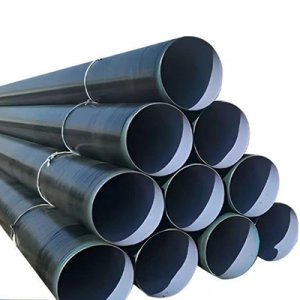
3PE anti-corrosion steel pipe is a commonly used anti-corrosion steel pipe. Its characteristics include the following aspects:
1. Material: The base material of 3PE anti-corrosion steel pipe is usually carbon steel pipe or alloy steel pipe, the coating material is polyethylene (PE), and the thickness of the anti-corrosion layer is generally 1.8-3.7mm.
2. Anti-corrosion layer structure: The anti-corrosion layer of 3PE anti-corrosion steel pipe is composed of bottom adhesive, middle layer polyethylene and outer layer polyethylene. The bottom adhesive is used to bond the pipe body and the middle layer polyethylene, and the middle layer polyethylene is used for bonding. To prevent corrosion, the outer layer of polyethylene is used to protect the middle layer of polyethylene and enhance the mechanical properties of the pipe body.
3. Technical standards: The technical standards of 3PE anti-corrosion steel pipes usually include national standards, industry standards and enterprise standards, such as GB/T23257-2009 “Technical Specifications for Three-Layer Polyethylene Fatty Acid Copolymer Coating for External Anti-corrosion Steel Pipes”.
4. Scope of application: 3PE anti-corrosion steel pipes are usually suitable for pipeline systems transporting oil, natural gas, chemicals and other media to improve the corrosion resistance and service life of the pipeline system.
5. Packaging and transportation: 3PE anti-corrosion steel pipes usually require professional packaging and transportation methods, such as steel frame support, wooden board packaging, anti-collision and shockproof, etc., to ensure the safety of the product during transportation.
6. Other requirements: Depending on the specific usage requirements and the special requirements of the pipeline system, 3PE anti-corrosion steel pipes may also need to meet other requirements, such as high temperature resistance, low temperature resistance, fire protection, explosion protection, etc.
Contact
- Tel:+86 317 6019016
- Contact person:Mr. Dai
- Wechat:13102449099
- Mobile:+86 1310 244 9099
- E-mail:18713768122@163.com

